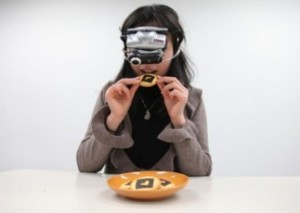
It is often observed that whenever food lovers see the line-up of their favourite dishes in a party or at a holiday dinner they fill their plate high by putting a little extra from each dish. However, in the end such people usually fail to finish their extra-large portions of meal, proving to an extent the old adage that says “your eyes were bigger than your stomach!”
However, researchers from the University of Tokyo have proven with their latest invention that this citation is true indeed, as they discovered that there is a link between appetite and vision. The researchers at this university have developed an Augmented Reality (AR) system that can manipulate a person’s mind by depicting the size of the food to appear larger or more voluminous than what it actually is.
As a result, this AR vision makes the person believe that they have eaten more than they actually did. The researchers developed this system because they believe that the feeling of being ‘full’ is partly determined by how much food a person has seen or believed himself eating. Therefore, by increasing the size of food through the AR vision they want to make a person feel full quicker.
The AR system makes this possible with the help of a camera that is mounted in front of a pair of glasses. When a user looks at the food he or she will instantly see the augmented reality vision that is streamed through the signals sent by the camera. Before streaming the vision to the pair of glasses these camera signals are processed by an algorithm, so it can makes the food look bigger and also portrays that the user’s hand is opening wide to hold the large piece or portion. Hence the user feels as if he or she has eaten something larger than they actually did.
To prove their point researchers at the University of Tokyo conducted a test which proved that their system works efficiently. Users involved ate 10 percent less food because the system made their food portion appear 1.5 times larger than it actually was. The interesting part about this system is that it can work in reverse as well as it can show a meal portion being smaller than it’s actual, which will can help increase the appetite of the user.
At this point in time the researchers have not put this system into production, as they are looking to spruce up this prototype, so it can integrate with other gadgets. Moreover, once this system becomes perfect it would also be able to automatically detect healthy and unhealthy food and then increase or decrease the size of the meal or make the repast more appetizing by adding specific presentation and colours to it without any human intervention.
The creator of this system thought of adding these features because he wants to develop healthy eating habits in people, as it’s better to adapt to this “brain hack” approach instead of chemicals. However, to use this system users must still have some will power because if a person does not put on these glasses while eating meal the impact of the device will not be utilized.
Source: PSFK